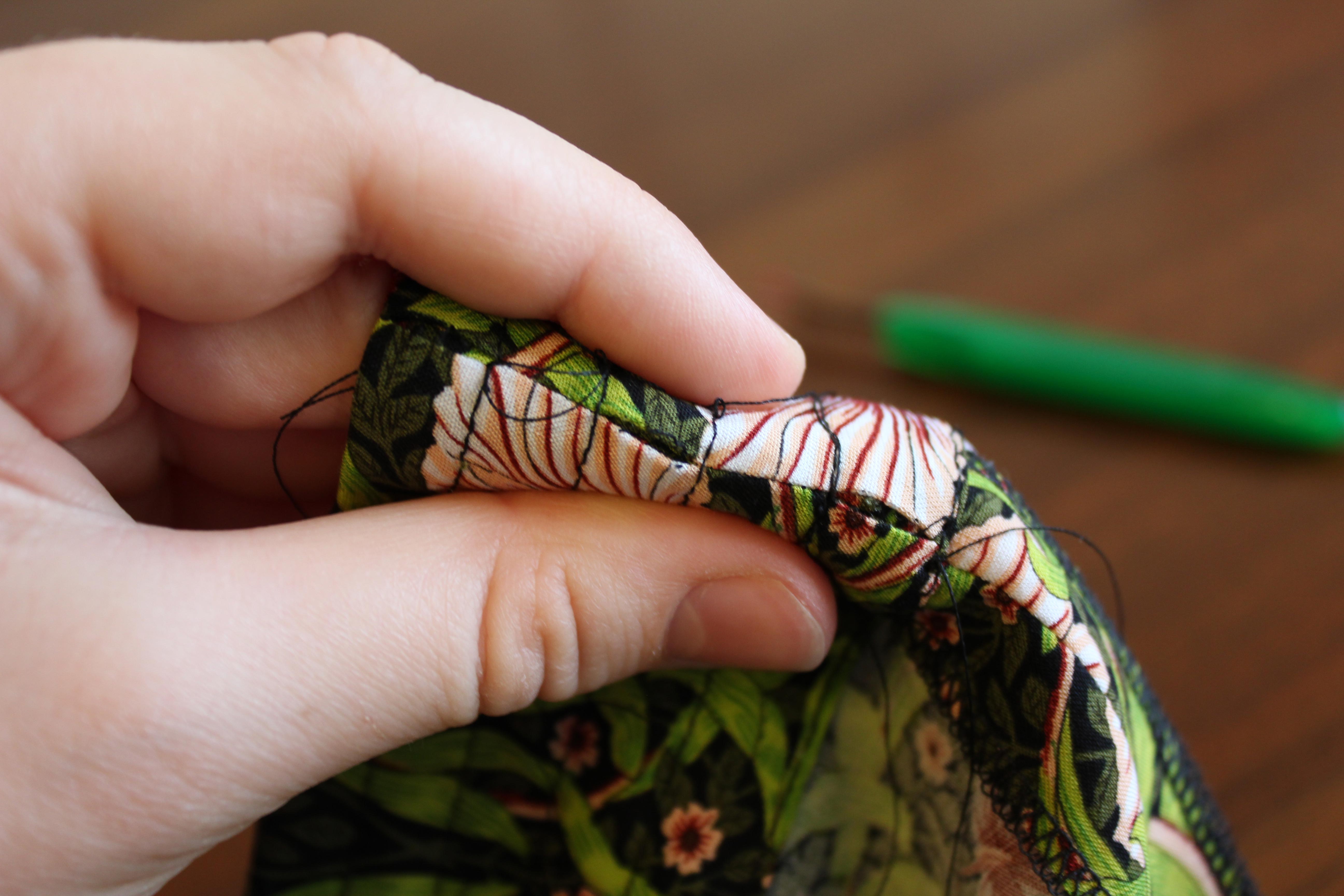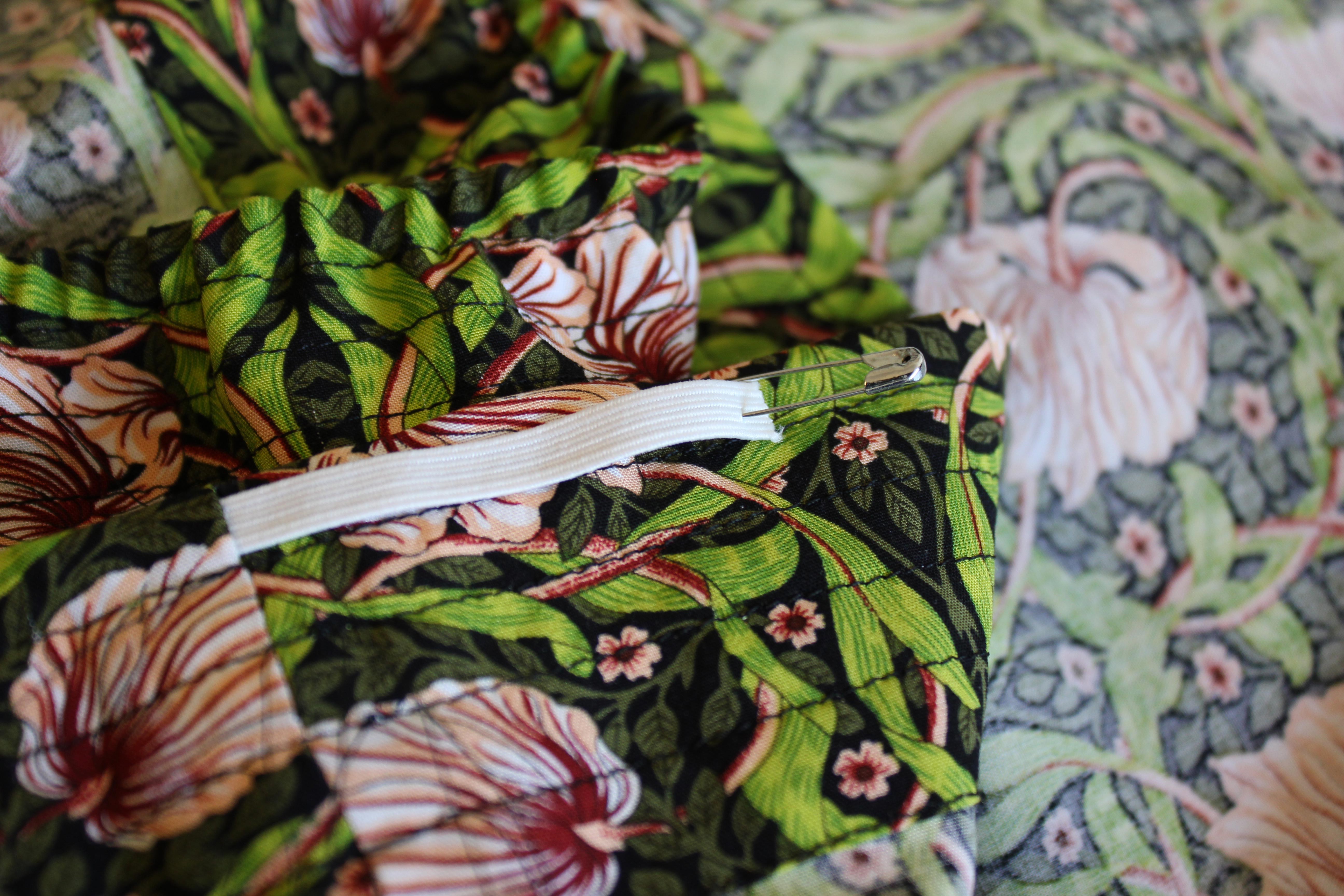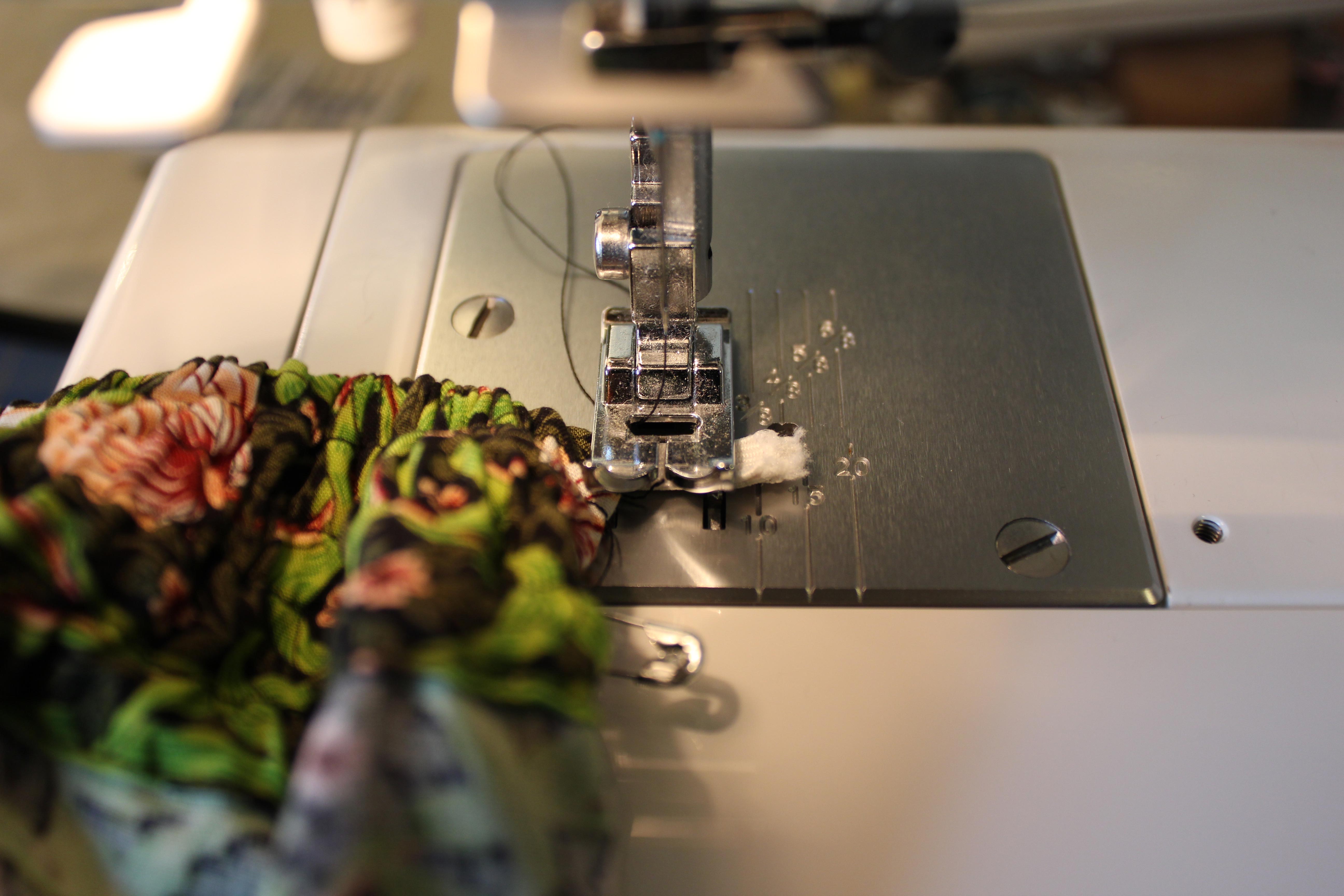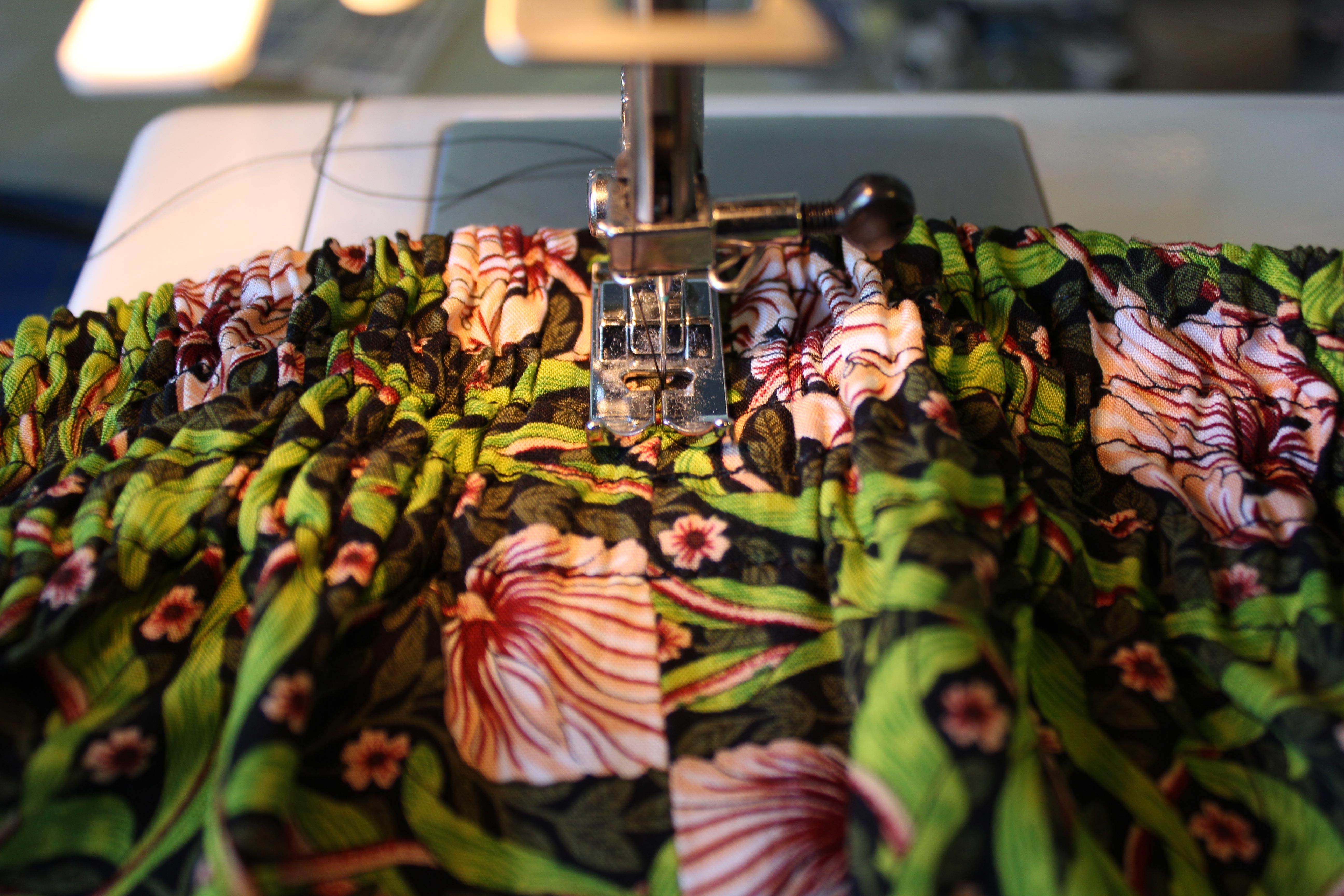
When I was a teenager, I pretty much only ever sewed one skirt pattern – a rectangle with a ruched elastic waistband. I made a version in cotton voile, which I wore on my first date with my husband. I made a version in flannel, before I knew how to choose appropriate fabrics for projects. I made a very bulky one out of cotton sateen, and one out of cheap cotton/poly batiste (which I am embarrassed to say, I still wear at home). It was just an incredibly versatile pattern.
I made all those skirts using instructions from Anna Maria Horner’s blog, where you can still find a PDF of the pattern for a lined skirt. I’ve since developed my own method of making this skirt, which I find quicker and uses less fabric (I found that most fabrics I used had no need for the lining). AMH’s pattern will work great for you if you’re using a very lightweight or sheer fabric.
Anyways, if you’d like to learn how I do it, please follow along! If you can sew a straight line on a sewing machine, you can make this super-easy skirt! The hardest part is inserting the elastic.
What You’ll Need:
- 1.5-2 yds fabric of your choice (I like flowy fabrics like rayon, you can use any lightweight fabric such as cotton voile/lawn. You could probably use silk, but it’ll be a bit trickier to sew the elastic channels).
- Matching thread
- Safety pins (I like to have both regular ones and the tiny ones on hand)
- 1/4″ wide elastic – enough for 3 times your waist measurement
- Seam ripper
Measuring and Cutting:
The only piece you’ll need to cut for this skirt is essentially a large rectangle.
For the width, you’ll want to measure at least 10″ more than your HIP measurement. I recommend cutting more than that, though, because it will give you more gathers at the waist. I went with the width of my fabric from selvedge to selvedge – 60″.
If your fabric isn’t very wide (44″ for example), fold the fabric in half and cut two rectangles at HALF your desired width.
The width you choose doesn’t need to be precise – just choose less width for less gathers (just make sure it is bigger than your hip measurement), and more width for more gathers (I find between 60-80″ total width is ideal).
For the length, determine your preferred skirt length, and add 2 3/8″ (for the waistband) and 1″ (for the hem). For example, if you want a 25″ long skirt, your rectangle will need to be 28 3/8″ tall.

Sewing:
Start by sewing the side seams, right sides together (1 seam if you only cut one rectangle, 2 seams if you cut two rectangles). Finish the seam and press open (I like to serge the edges first, before sewing, using a 3-thread overlock stitch).

Then, you’ll want to fold over the top edge of your skirt 1/2″ and press. Then fold again 2″ in, and press well. You can pin the fold in place if you want, but if your folds are crisp I don’t find it necessary. Make sure to keep the fold the same width all the way around.

Now we’re going to stitch the elastic channels. Make sure the folded edge of your skirt is lined up with the 3/8″ mark on your sewing machine. You want to make sure that you stay at (or slightly, slightly past) that line – if you go below it, your elastic may not fit through. Stitch all the way around until you meet back up with the beginning.

Move the edge of the skirt to the 6/8″ mark, and stitch around like you did before. We will be creating a gap between the first elastic channel and the second one.
Repeat this step one more time to create the second elastic channel. At this point, I’ll have run out of lines on my machine to measure by. You can either mark your machine with a line of tape, or do what I do, and keep a careful eye on the distance between the presser foot and the previous line of sewing (for me there is a 1/8″ gap between the edge of the foot and the stitch line).

Then, flip your skirt over so that you can see the bottom fold of the waistband. Carefully stitch right along the folded edge.

Now for the final row of stitches. Line up your needle between the last two rows you stitched, and sew all the way around. I flipped the skirt back to the right side, but you can do this from whichever side you prefer.
The elastic channels are now finished! Your waistband should look like this.

Now we can actually insert the elastics. At the back/side seam, on the INSIDE, carefully seam rip the first, third, and fifth channels. Make sure you don’t seam rip the seam at the right side of the skirt.

You’ll have three little holes through which to thread your elastic.

Now, cut off three lengths of elastic, each the length of your waist measurement (you can subtract 1-2″ if you want a tighter waistband. You can also tighten the elastics before sewing up the casing).
Attach a small safety pin to one end and a large one at the other. Make sure the pins aren’t pinned too close to the edge of the elastic, otherwise they might tear off in the middle of the channel, which is pretty frustrating – trust me.

Insert the end with the small pin into the first open channel, and use the pin to inch the elastic through.


Push the elastic all the way around the skirt, until you reach the opening again. The large safety pin should act as a “stopper” and keep the elastic from being pulled all the way through.
Once the elastic has been pulled all the way back to the beginning, pin the elastic ends together so they don’t slide into the skirt.

Repeat this process for the other two pieces of elastic. Your waistband should look like this.

Make sure the elastics aren’t twisted, and sew the pinned ends together. I like to sew back and forth several times to make sure it’s secure. Trim the elastic ends about 1/8″ from the stitching.

Pull the waistband to help ease the elastic ends inside the channels. Try on the skirt and make sure you’re happy with the snugness, and make sure the gathers are evenly distributed.
Use a ladder stitch or whip stitch to stitch up the channel openings. I find that after all the stretching, the gaps between the channels have opened up a bit as well, so I stitch the whole seam closed to make sure everything is secure. Sometimes the first channel opens up on the right side as well, so stitch that closed if you have to.

Then, lay your waistband flat and stitch in the ditch at the seam to secure the elastics and keep them from twisting around too much in their channels.
To finish, turn up and press the hem 1/2″ twice, and sew. You’re done! Try on your new skirt and give it a twirl!
If you have any questions, please let me know in the comments below!
You did a really great job on this tutorial! I have taught this skirt in sewing classes but never thought about using 1/4″ elastic in three rows. Neat!
LikeLike
Thank you!
LikeLike
What an awesome tutorial. I’m making gypsy skirts for my friends and this helps tremendously with how much extra fabric to measure for movement. Yay!! Also i like the idea of triple elastic. It looks way more polished than just one. Thanks for posting.
LikeLike
Thank you so much for your kind comment! I’m so glad you found my tutorial helpful 🙂
LikeLike
Beautiful! I too remember making this type of skirt at school. I am now 70 years old, new to sewing, living in hot, sultry Cairns and needing natural, comfortable clothing – then I found your lovely chatty, informative blog. I love the waistband, it really does make this simple design much more polished. Do you think giant pockets – similar to Peppermint Magazine’s pocket skirt – would be too much? And do you have any hints as to placement? Regards, Sandra
LikeLike
Hi Sandra – thanks so much for reading! Yes I can only imagine a flowy and comfy skirt would be perfect for beating the humidity there (I’ve only been to Cairns in the winter, can’t imagine what it’d be like in summer!). I think giant pockets would be fabulous! I think a good way to find placement for them is to simply put on the skirt and see where your hands would naturally land if you were to put them in there. I prefer over the side seams rather than in front, but it depends on the look you’re going for 🙂 Really glad to hear you’re getting into sewing 🙂
LikeLike
Like it. Simple, yet fancy!
LikeLike
Thank you!
LikeLiked by 1 person
Thought it was super cool!
LikeLike
I love your tutorial, very easy to follow! Question: I am pear shaped and my hips are more than 10” + my waist measurement. Do I have to cut rectangular shapes of fabric or can I angle them somewhat, so there is not so much bulk at the waistline after the skirt is completed?
LikeLike
Hi Cate – thanks for your comment! I am pear shaped as well. It is really important that whatever size you make the rectangles, you make them bigger than your hips – otherwise the skirt won’t be able to stretch over. My waist is 31″ and my hips 43″-ish (it’s honestly been a while since I measured them). It helps to use a fabric that is lightweight so there isn’t bulk at the waist. As I mentioned, 60″-80″ total width is my sweet spot. If you go much smaller, it won’t be gathered! You can still angle your pieces so they flare more as they go towards the hem if you want more volume and less bulk – but you’ll still want a good amount of width starting at the top for some nice gathering (so for example, for me I would angle from 60″ at the waist out to 70″ at the hem, and draw a diagonal between the two).
I hope that helps but of course let me know if you have further questions!
LikeLike
Your last 2 sentences lost me. Can you explain to the level of “angle your pieces for dummies?”
LikeLike
Hi Sue! Basically, this reader wants a skirt that will be a bit more a-line/flared. My instructions explain that you start out by “drawing” a rectangle with straight sides. To get more of an a-line, you’d want to “draw” a shape that is more of a trapezoid than a rectangle (at risk of confusing you further it’s actually considered a big no-no in the pattern drafting world when drafting an a-line skirt, and I haven’t tried this myself, but I’ve also read that adding a few inches isn’t going to make or break your project…but that’s a whole other pattern drafting-related conversation – you can read a bit about that here https://designerstitch.com/adding-or-reducing-flare-on-a-pattern-piece/)
But basically, what I was explaining above is that you could start out with a rectangle that is, say 60″x 22″. At the base of the rectangle, at both sides, you could measure out and mark, say, 3″. Then, from the top corner of each side of the rectangle, you would draw a line connecting the top corners to the marks you just made, essentially, giving the bottom of the skirt more width than the top. (In the link above there’s a picture of how this would look with a big x over it – ha!) Basically, this method is not the ideal way to add flare to a skirt. I imagine though for a gathered skirt like in this tutorial, it should work ok.
I hope that clears things up a bit and I’m sorry if I only added more confusion with my pattern drafting geekiness!
LikeLike
I can’t wait to try this tutorial! The whole thing makes sense to me. Thank you!
LikeLike
I’m so glad 🙂 Thanks for reading, Sue!
LikeLike
I just love this skirt! I’ve made my granddaughters several for Halloween, Fall and Christmas. Getting one ready for a birthday- mermaid fabric. Thanks so much!
LikeLike
I’m so happy to hear that, Tonia! Love the idea of it in mermaid fabric! Thanks for reading 🙂
LikeLike
Thank you for the tutorial. I am going to try your method. If you ever have the time please do this again with a light colored and solid fabric. Thanks again. 😊
LikeLike
I’m excited to sew a few of these skirts. I’ve always used 1” elastic for my skirts but your way looks more comfortable. Thank you for sharing. 🙂
LikeLike
Hi, do you have instructions for the same skirt with pockets?
LikeLike
Hi Deborah – I’m sorry, but I don’t. It would be easy enough to add pockets to, though! Here’s a tutorial on how you can make that change – https://www.tillyandthebuttons.com/2017/10/how-to-add-in-seam-pockets-to-garment.html
You would simply follow those steps at the same point where the rectangles would be sewn together.
Hope that helps!
LikeLike
Thank you for your very easy to follow instructions. I made a beautiful rayon skirt today. My only goof was I sewed the seam with French seams techno and when it came time to put the elastic in, I had to do a little extra scissors work to get through. But no matter it came out well.
LikeLike
Thank you Deb! I’m so happy to hear my tutorial was helpful. I love a good french seam but can see how that would be troublesome! Glad it worked out 🙂
LikeLike
Hello! Thanks for this tutorial. I recently purchased elastic that is a little less than an inch wide, but when I sewed it into the top band of a similar skirt, the fabric there just looked loose and frumpy. Another tutorial I found recommend stretching the elastic and sewing it all the way around so that the fabric would bunch with the elastic, but it just doesn’t quite look right! Do you have any advice for using 1-inch elastic (instead of separate, smaller ones)?
LikeLike
Hi Katie – thanks for reading! I also find that a wider elastic looks kind of funny most of the time, but I usually like how it looks with it sewn down all the way around (I do this with most of my skirts now!). It takes practice to get it looking nice though, and I’m not always pleased with the result, if I’m honest!
Otherwise I find if I use something wider than 1″, like 1.5″, usually looks neater on its own, without any stitching on top – and that way you only need the one.
If you look at my Instagram, my most recent skirt is an example of a stitched-down, 1″ elastic (that I wasn’t so happy with!) and the skirt before that is a wider one with no stitching on top.
I hope that helps!
LikeLike
I’d love to make this using a cotton viole I already have that is pretty sheer. Any advice for adding a lining? The link to the blog post you mentioned is no longer active.
LikeLike
In that case (and this is what the tutorial in the aforementioned blog post does) you would sew another rectangle the same size to go inside the one sewn from the cotton voile. Then, instead of folding over the top, you would sew the top edge with right sides together, flip the lining to the inside, press, and sew the channels with the lining on the other side instead of folding the top of the main fabric down. I hope that makes sense?
LikeLike